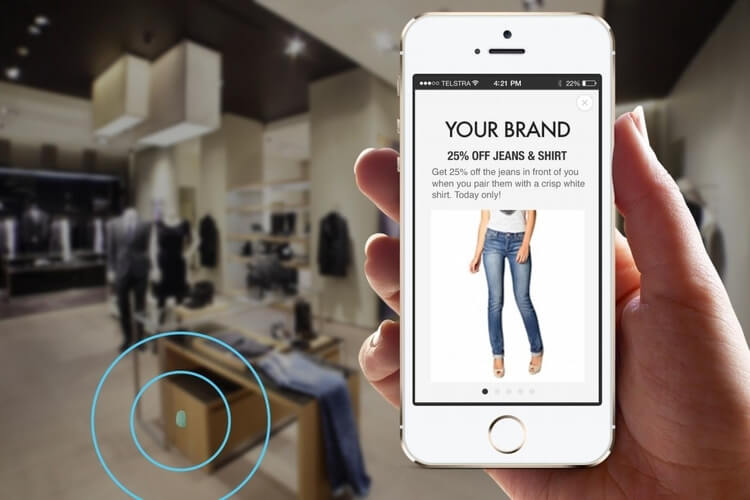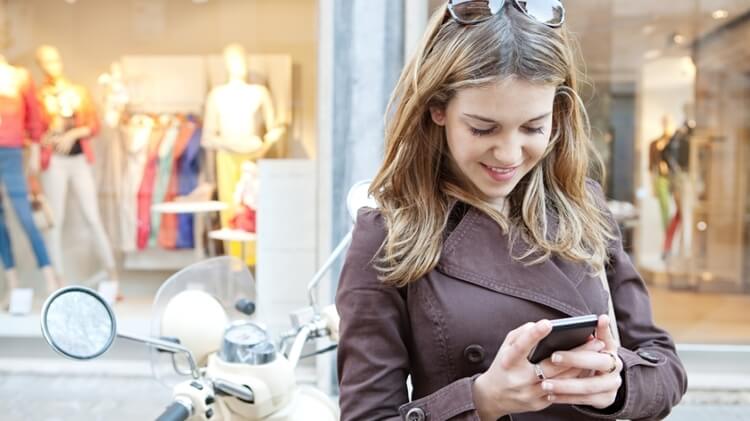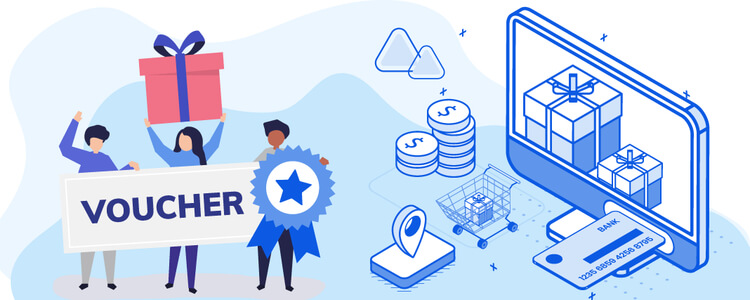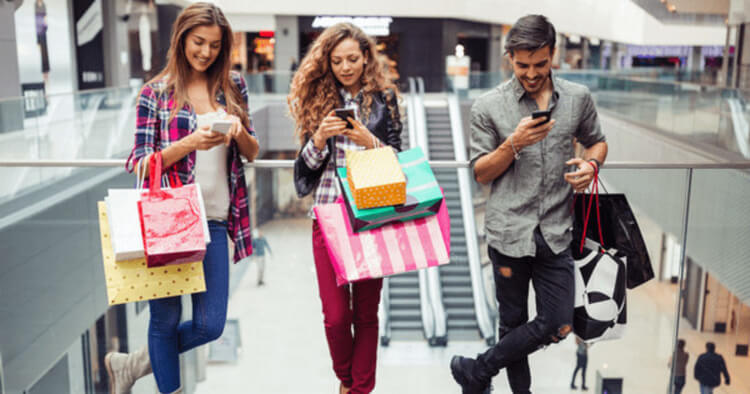Using Bluetooth beacons in retail is a fast, low-investment way to connect with your in-store customers. Not only does it enable you to engage with the right people at the right time, but proximity beacons can provide valuable customer insights to help you refine your marketing campaigns.

More than 70% of shoppers say Bluetooth beacon-triggered content and offers increased their likelihood to purchase in store. And the market is booming. According to a recent research report, the global proximity beacon market is expected to reach a whopping $103.94 billion by 2030, with retail leading the way.
What’s more, beacons in retail are fairly inexpensive to set up. The beacons themselves are widely available, while the cost of adding beacon technology in your app is only a small amount of the app development costs, especially when you use an cost-effective solution such a PlotProjects.
Want to find out more about using Bluetooth beacons in retail? Read on to find out the best beacon marketing examples to boost in-store sales in 2022 and beyond.
What is beacon technology in retail?
Firstly, let’s look at what we mean by ‘beacon technology in retail’. A Bluetooth beacon is a small hardware devices that transmits Bluetooth signals to nearby smartphones. In retail, Bluetooth beacons can communicate with customers who have their bluetooth enabled and the relevant retail app downloaded on their phone.
Using beacon technology in retail opens the door to many proximity marketing opportunities. Also known as ‘proximity marketing beacons’ or ‘proximity beacon marketing’, this powerful and cost-effective tool enables businesses to target nearby customers with location-based notifications such as discounts, deals and other alerts.
For example, imagine walking into your favorite department store looking for a great deal, then suddenly your smartphone pings and you see a notification from the brand you were looking for with a discount off your next purchase. Or perhaps you can’t find what you need? Bluetooth beacons can combat this problem by helping you navigate your way around.
None of this is as futuristic as it might sound. Major retailers like Target, Macy’s, Walmart and Tesco are already making a mark with their proximity beacon campaigns. And with more and more users shifting their searches to smartphones, the adoption of beacon technology in retail is increasing at a rapid pace.
Benefits of using Bluetooth beacons in marketing
There are so many benefits of using Bluetooth beacons in your proximity marketing campaigns, here’s a look at just a few (note that in this section we use the terms ‘Bluetooth beacons’, ‘BLE beacons’ and ‘proximity beacons’ interchangeably).
Proximity beacons offer a personalized customer experience
Because proximity beacons are focussed on customer location, retailers are able to send highly relevant and personalized notifications at exactly the right moment. For instance, welcoming a customer when they arrive in store, or if a customer is in a particular part of a department store, the Bluetooth beacon can trigger offers aligned with that location.
Valuable customer insights
Using Bluetooth beacons in retail enables businesses to gather valuable insights about their customers. Retail beacons can capture data like when a customer shops, how long they spend in store and what items they typically buy. Businesses can use this data to refine their beacon marketing campaigns and make in-store adjustments.
Better customer engagement
Not only does proximity beacon marketing offer an opportunity for increased customer engagement, but also better engagement. It’s used for sending customers useful content such as discounts and deals, along with helpful alerts and guidance. Because of this, customers are more likely to engage with your app consistently.
Bluetooth beacons can be combined with geofencing
Bluetooth beacons and geofencing offer the perfect combination of technologies for proximity marketing. Geofences are virtual boundaries that can be drawn around specific geographic locations, triggering mobile notifications when a user enters or exits the area. The range of geofences is wider than that of beacons, making them a good addition to your campaigns, especially if you want to target users in your neighborhood, or even for geo-conquesting your competitors.
Proximity beacons – how they work
Still confused about how beacon marketing works? This video from Adcoach explains everything you need to know.
9 beacon marketing examples to boost sales
Retailers around the world are using Bluetooth beacons as part of their mobile marketing strategy. Here are some of the best tried-and-tested proximity beacon marketing examples to help you boost footfall and sales in 2022 and beyond
1. Use proximity beacons to send great discounts and deals
Who doesn’t love a great deal? Use Bluetooth beacon targeting to send your in-store customers great deals and discounts. Not only will it influence their in-store purchase decisions, but it’ll encourage them to opt-in to receiving your notifications.
Red Bull rolled out proximity marketing campaigns at 1400 convenience stores in Canada. Bluetooth beacons were installed at the retail point to trigger notifications offering two cans of Red Bull for $4. Not only did this beacon targeting campaign drive sales significantly, but Red Bull captured a ton of valuable customer data.
2. Guide customers to what they need
Large stores can be tricky to navigate. Retail beacons can help with this problem by guiding customers directly to what they’re looking for.
Gatwick Airport leveraged 2,000 beacons to offer an indoor navigation and augmented reality wayfinding service that guides passengers to specific locations within the airport terminal. Similarly, Target uses proximity beacons to map routes for customers to help them find the items on their in-app shopping lists.

3. Understand customer behaviour
Using beacon technology in retail is a powerful way to gather real-time information about your customers’ in-store behaviour. By monitoring their in-store movements you are able to deliver hyper-targeted notifications and discounts depending on what location they are in. For instance, a discount for shoes while the customer is in the shoe department.
Retailers are also able to capture rich data on consumer behaviour, like how much time a customer spends in each department, how they navigate around the space, or even how many customers are walking by the store front but not entering. This can be used to plan better content strategies, store layouts and retail merchandising.
4. Leverage beacon marketing for loyalty programs
Bluetooth beacon marketing can be used for a whole lot more than sending deals and discounts. Many retailers are using beacons to boost their customer loyalty programs. All loyalty related information can be saved directly on a user’s smartphone app and updated in real time when a customer receives points.
Sephora is a great example of brands using proximity beacons to promote loyalty. Their ‘Beauty Insider’ program offers access to exclusive perks, discounts and deals like ‘mini makeover’ and coupon notifications. BLE beacons are placed around stores to send alerts related to a shopper’s proximity to products and billing points.

5. Promote in-store events with beacon-triggered alerts
Customers are more likely to attend your in-store events if you alert them when they’re nearby. This can be especially valuable during the sales or holiday seasons. Retail beacons can be placed in specific departments such as clothing, jewelry or cosmetics to promote specific events going on there.
Neiman Marcus uses beacon targeting to promote in-store holiday events such as trunk shows, guest designers and makeup artist appointments. The notifications alert app users to the event details and directions when a consumer is present at the store.
6. Beacon marketing to increase conversions
Clever beacon marketing campaigns can entice customers into making a purchase. For instance, a shopper who has been in a specific department for a while might be deciding whether or not to make a purchase. Sending a notification with a discount code at this ‘point of purchase’ stage might tempt the customer to purchase the product they were looking at for a while.
Using the data you collect is another valuable way to increase conversions. Perhaps a user has put tea bags on their shopping list. When they’re at the right location, why not upsell related items like milk and sugar? This type of targeted messaging is likely to lead to higher conversion rates than generic ads.
7. Combine Bluetooth beacons and geofences
Geofencing and beacons are complementary technologies. They can be used together to enhance mobile marketing campaigns. Since geofencing works best on larger distances and beacons on smaller ones, marketing campaigns can be designed to first attract nearby app users to a location and then interact with them once inside a location using beacons.

8. Enhance the shopping experience
Make your store so much more than just a place to acquire merchandise. Proximity marketing beacons can help retailers move away from a transaction mindset to one focussed on enhancing the shopping experience, giving customers more than they expect.
Macy’s famously used Bluetooth beacon targeting to trigger alerts for a mobile instant win game in store during the Black Friday weekend. It was a great way to drive some excitement at what is typically a very busy time. App users had the chance to win $1 million in Macy’s gift codes and prizes by shopping in their local store.
9. Bridge the gap between online and offline
Ever since digital channels came to the forefront, retailers have been trying to bridge the gap between offline and online channels. The perfect resource for brick-and-mortar stores, beacons are a way to do just that; drive customer engagement and connect in-store and online shopping.
By connecting the signals of your proximity beacons to your ads account, you can gain insights into your users offline activity. For example, your user types in the search term ‘smart black shoes’ and then clicks on your search ad. If they decide to visit your store, your beacons will recognize the user and link the data with your ads account as a store visit.
In addition, when the user enters the store you can send a push notification for 20% off the shoes they were looking at online. Perfectly bridging the gap between online and offline experiences.
Get started with beacon marketing
At PlotProjects we offer reliable, scalable and cost-effective location technology to help you take your location-based notifications to the next level. Easy to integrate across your entire digital infrastructure, our plugin has got you covered with geofences, beacons and polygons, along with a robust analytics and location data platform, and dedicated customer support at every stage of the way.
Contact us today to find out more about how we can you build accurate and efficient location functionalities into your mobile apps. Or try our free software and see the benefits for yourself. Start today and discover why businesses of all sizes choose PlotProjects as their location technology provider.
Other useful resources
- A scroll-and-stop guide to geofences and beacons
- Examples of geofencing to inspire your campaigns
- Geofencing companies – how to choose the right one
- Geofencing for mobile apps
- How to set up geofencing
